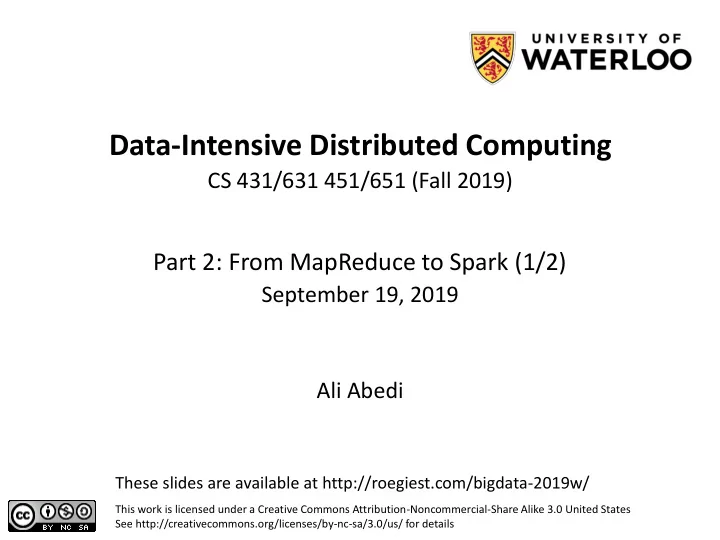

Data-Intensive Distributed Computing CS 431/631 451/651 (Fall 2019) Part 2: From MapReduce to Spark (1/2) September 19, 2019 Ali Abedi These slides are available at http://roegiest.com/bigdata-2019w/ This work is licensed under a Creative Commons Attribution-Noncommercial-Share Alike 3.0 United States See http://creativecommons.org/licenses/by-nc-sa/3.0/us/ for details
The datacenter is the computer! What’s the instruction set? Source: Google
So you like programming in assembly? Source: Wikipedia (ENIAC)
What’s the solution? Design a higher-level language Write a compiler
Hadoop is great, but it’s really waaaaay too low level! What we really need is a What we really need is SQL! scripting language! Answer: Answer:
SQL Pig Scripts Both open-source projects today!
Hive Pig MapReduce HDFS
Pig! Source: Wikipedia (Pig)
Pig: Example Task: Find the top 10 most visited pages in each category Visits URL Info User Url Time Url Category PageRank Amy cnn.com 8:00 cnn.com News 0.9 Amy bbc.com 10:00 bbc.com News 0.8 Amy flickr.com 10:05 flickr.com Photos 0.7 Fred cnn.com 12:00 espn.com Sports 0.9 Pig Slides adapted from Olston et al. (SIGMOD 2008)
Pig: Example Script visits = load ‘/data/visits’ as (user, url, time); gVisits = group visits by url; visitCounts = foreach gVisits generate url, count(visits); urlInfo = load ‘/data/ urlInfo ’ as (url, category, pRank); visitCounts = join visitCounts by url, urlInfo by url; gCategories = group visitCounts by category; topUrls = foreach gCategories generate top(visitCounts,10); store topUrls into ‘/data/ topUrls ’; Pig Slides adapted from Olston et al. (SIGMOD 2008)
Pig Query Plan load visits group by url foreach url load urlInfo generate count join on url group by category foreach category generate top(urls, 10) Pig Slides adapted from Olston et al. (SIGMOD 2008)
Pig: MapReduce Execution Map 1 load visits group by url Reduce 1 Map 2 foreach url load urlInfo generate count join on url Reduce 2 Map 3 group by category Reduce 3 foreach category generate top(urls, 10) Pig Slides adapted from Olston et al. (SIGMOD 2008)
visits = load ‘/data/visits’ as (user, url, time); gVisits = group visits by url; visitCounts = foreach gVisits generate url, count(visits); urlInfo = load ‘/data/ urlInfo ’ as (url, category, pRank); visitCounts = join visitCounts by url, urlInfo by url; gCategories = group visitCounts by category; topUrls = foreach gCategories generate top(visitCounts,10); store topUrls into ‘/data/ topUrls ’;
But isn’t Pig slower? Sure, but c can be slower than assembly too…
Pig: Basics Sequence of statements manipulating relations Data model atoms tuples bags maps
Pig: Common Operations LOAD: load data (from HDFS) FOREACH … GENERATE: per tuple processing FILTER: discard unwanted tuples GROUP/COGROUP: group tuples JOIN: relational join STORE: store data (to HDFS)
Pig: GROUPing A = LOAD 'myfile.txt ’ AS (f1: int, f2: int, f3: int); (1, 2, 3) (4, 2, 1) (8, 3, 4) (4, 3, 3) (7, 2, 5) (8, 4, 3) X = GROUP A BY f1; (1, {(1, 2, 3)}) (4, {(4, 2, 1), (4, 3, 3)}) (7, {(7, 2, 5)}) (8, {(8, 3, 4), (8, 4, 3)})
Pig: COGROUPing A: B: (1, 2, 3) (2, 4) (4, 2, 1) (8, 9) (8, 3, 4) (1, 3) (4, 3, 3) (2, 7) (7, 2, 5) (2, 9) (8, 4, 3) (4, 6) (4, 9) X = COGROUP A BY $0, B BY $0; (1, {(1, 2, 3)}, {(1, 3)}) (2, {}, {(2, 4), (2, 7), (2, 9)}) (4, {(4, 2, 1), (4, 3, 3)}, {(4, 6),(4, 9)}) (7, {(7, 2, 5)}, {}) (8, {(8, 3, 4), (8, 4, 3)}, {(8, 9)})
Pig: JOINing A: B: (1, 2, 3) (2, 4) (4, 2, 1) (8, 9) (8, 3, 4) (1, 3) (4, 3, 3) (2, 7) (7, 2, 5) (2, 9) (8, 4, 3) (4, 6) (4, 9) X = JOIN A BY $0, B BY $0; (1,2,3,1,3) (4,2,1,4,6) (4,3,3,4,6) (4,2,1,4,9) (4,3,3,4,9) (8,3,4,8,9) (8,4,3,8,9)
Pig UDFs User-defined functions: Java Python JavaScript Ruby … UDFs make Pig arbitrarily extensible Express “core” computations in UDFs Take advantage of Pig as glue code for scale-out plumbing
The datacenter is the computer! What’s the instruction set? Okay, let’s fix this! Source: Google
MapReduce Workflows HDFS map map map map reduce reduce reduce reduce HDFS HDFS HDFS HDFS What’s wrong?
Want MM? HDFS HDFS map map map map ✗ HDFS HDFS HDFS ✔
Want MRR? HDFS HDFS map map map reduce reduce reduce reduce ✗ HDFS HDFS HDFS ✔
The datacenter is the computer! Let’s enrich the instruction set! Source: Google
Spark Answer to “What’s beyond MapReduce?” Brief history: Developed at UC Berkeley AMPLab in 2009 Open-sourced in 2010 Became top-level Apache project in February 2014
Spark vs. Hadoop November 2014 Google Trends Source: Datanami (2014): http://www.datanami.com/2014/11/21/spark-just-passed-hadoop-popularity-web-heres/
Recommend
More recommend